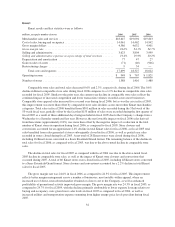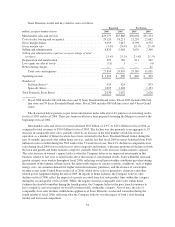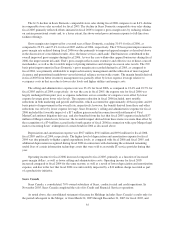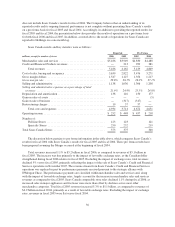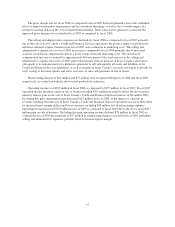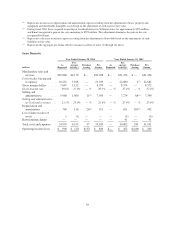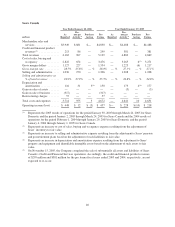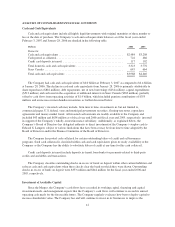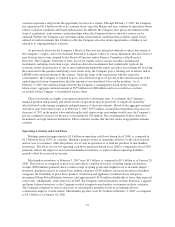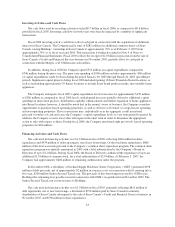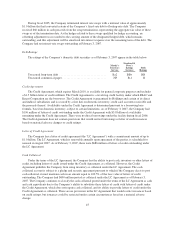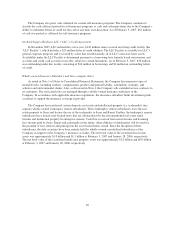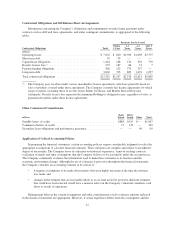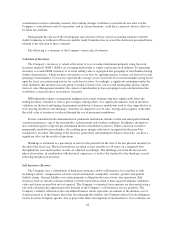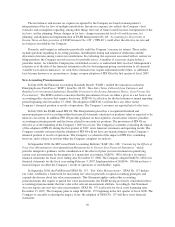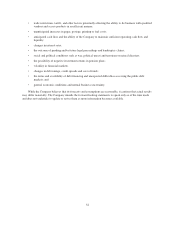Sears 2006 Annual Report Download - page 42
Download and view the complete annual report
Please find page 42 of the 2006 Sears annual report below. You can navigate through the pages in the report by either clicking on the pages listed below, or by using the keyword search tool below to find specific information within the annual report.customer experience and provide the opportunity for attractive returns. Through February 3, 2007, the Company
has repurchased $1.4 billion worth of its common shares since the Merger and may continue to repurchase shares
subject to market conditions and board authorization. In addition, the Company may pursue investments in the
form of acquisitions, joint ventures and partnerships where the Company believes attractive returns can be
obtained. Further, the Company may determine under certain market conditions that available capital is best
utilized to fund investments that it believes offer the Company attractive return opportunities, whether or not
related to its ongoing business activities.
As previously disclosed, the Company’s Board of Directors has delegated authority to direct investment of
the Company’s surplus cash to its Chairman, Edward S. Lampert, subject to various limitations that have been or
may be from time to time adopted by the Board of Directors and/or Finance Committee of the Board of
Directors. The Company, from time to time, invests its surplus cash in various securities and financial
instruments, including total return swaps, which are derivative instruments that synthetically replicate the
economic return characteristics of one or more underlying marketable equity securities. In exchange for receiving
the return tied to the position underlying a total return swap, the Company pays a floating rate of interest tied to
LIBOR on the notional amount of the contract. Under the terms of the transactions with the respective
counterparties, the Company is required to post cash collateral of up to 25 percent of the notional amount of the
underlying total return swap position, plus the amount of any unrealized losses on the positions. As of
February 3, 2007, the collateral balance held by the Company’s counterparties based on the Company’s total
return swaps’ aggregate notional amount of $375 million was $80 million and was recorded as a current
receivable on the Company’s consolidated balance sheet.
These investments are highly concentrated and involve substantial risks. Accordingly, the Company’s
financial position and quarterly and annual results of operations may be positively or negatively materially
affected based on the timing, magnitude and performance of these investments. Based on the aggregate notional
amount of such total return swaps as of February 3, 2007, $375 million, an immediate hypothetical increase (or
decrease) of 20% in the market value underlying the total return swaps outstanding would cause the Company’s
pre-tax earnings to increase (or decrease) concurrently by $76 million. The counterparties to these derivative
instruments are large financial institutions. These estimates assume that the total return swap portfolio remains
constant.
Operating Activities and Cash Flows
Holdings generated approximately $1.4 billion in operating cash flows during fiscal 2006, as compared to
$2.3 billion in fiscal 2005. As a retailer, Holding’s primary source of operating cash flows is the sales of goods
and services to customers, while the primary use of cash in operations is to fund the purchase of merchandise
inventories. The lower level of net operating cash flows generated during fiscal 2006 as compared to fiscal 2005
primarily reflects the impact of increased merchandise inventories, as well as reduced operating liabilities,
partially offset by increased net income.
Merchandise inventories at February 3, 2007 were $9.9 billion, as compared to $9.1 billion as of January 28,
2006. The increase as compared to prior year end reflects a number of factors, including timing of inventory
receipts ($200 million) primarily due to earlier receipt of spring goods and a higher level of in-transit import
inventory, planned increases in certain basic fashion categories ($130 million), increased inventory in hardline
categories ($120 million) to place Sears products (Craftsman and appliances) in Kmart stores and pursue
incremental Home Décor/Furniture business, and approximately $140 million attributable to lower than expected
sales levels. Additionally, at the end of fiscal 2005, the Company reduced inventory in Sears Domestic’s apparel
and home fashion businesses as the Company worked to improve merchandise assortments in these categories.
The Company continues to review and assess its merchandise inventory levels in an ongoing effort to
continuously improve overall returns. Merchandise payables were $3.3 billion at February 3, 2007, as compared
to $3.5 billion as of January 28, 2006.
42


